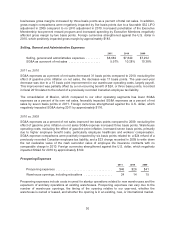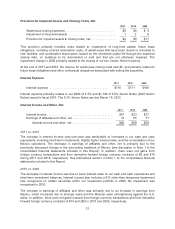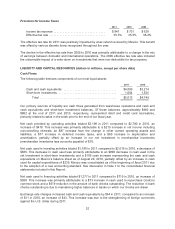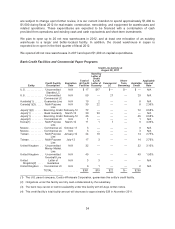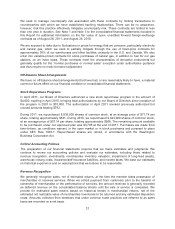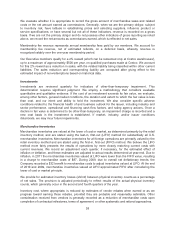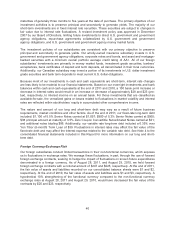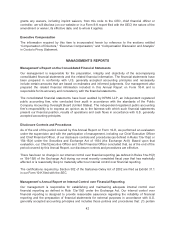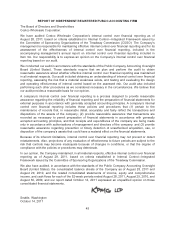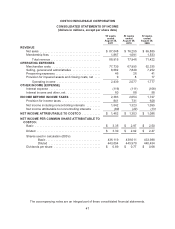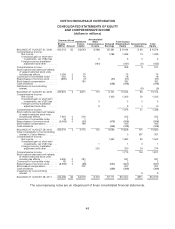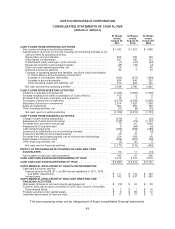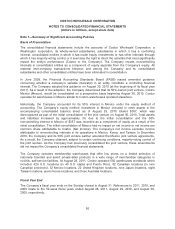Costco 2011 Annual Report Download - page 42
Download and view the complete annual report
Please find page 42 of the 2011 Costco annual report below. You can navigate through the pages in the report by either clicking on the pages listed below, or by using the keyword search tool below to find specific information within the annual report.maturities of generally three months to five years at the date of purchase. The primary objective of our
investment activities is to preserve principal and secondarily to generate yields. The majority of our
short-term investments are in fixed interest rate securities. These securities are subject to changes in
fair value due to interest rate fluctuations. A revised investment policy was approved in December
2007 by our Board of Directors, limiting future investments to direct U.S. government and government
agency obligations, repurchase agreements collateralized by U.S. government and government
agency obligations, and U.S. government and government agency money market funds.
The investment policies of our subsidiaries are consistent with our primary objective to preserve
principal and secondarily to generate yields. Our wholly-owned insurance subsidiary invests in U.S.
government and government agency obligations, corporate notes and bonds, and asset and mortgage-
backed securities with a minimum overall portfolio average credit rating of AA+. All of our foreign
subsidiaries’ investments are primarily in money market funds, investment grade securities, bankers’
acceptances, bank certificates of deposit and term deposits, all denominated in their local currencies.
Additionally, our Canadian subsidiary may invest a portion of its investments in U.S. dollar investment
grade securities and bank term deposits to meet current U.S. dollar obligations.
Because most of our investments in cash and cash equivalents are short-term, interest rate changes
are less likely to be material to our financial statements. Based on our overnight investments and bank
balances within cash and cash equivalents at the end of 2011 and 2010, a 100 basis point increase or
decrease in interest rates would result in an increase or decrease of approximately $29 and $23 (pre-
tax), respectively, to interest income on an annual basis. For those investments that are classified as
available-for-sale, the unrealized gains or losses related to fluctuations in market volatility and interest
rates are reflected within stockholders’ equity in accumulated other comprehensive income.
The nature and amount of our long and short-term debt may vary as a result of future business
requirements, market conditions and other factors. As of the end of 2011, our fixed-rate long-term debt
included: $1,100 of 5.5% Senior Notes carried at $1,097; $900 of 5.3% Senior Notes carried at $900;
$38 principal amount at maturity of 3.5% Zero Coupon Convertible Subordinated Notes carried at $31;
and additional notes totaling $86. Additionally, our variable rate long-term debt included a 0.35% over
Yen Tibor (6-month) Term Loan of $39. Fluctuations in interest rates may affect the fair value of the
fixed-rate debt and may affect the interest expense related to the variable rate debt. See Note 4 to the
consolidated financial statements included in this Report for more information on our long and short-
term debt.
Foreign Currency-Exchange Risk
Our foreign subsidiaries conduct limited transactions in their non-functional currencies, which exposes
us to fluctuations in exchange rates. We manage these fluctuations, in part, through the use of forward
foreign exchange contracts, seeking to hedge the impact of fluctuations on known future expenditures
denominated in a foreign currency. As of August 28, 2011, and August 29, 2010, we held forward
foreign exchange contracts with a notional amount of $247 and $225, respectively. At the end of 2011,
the fair value of assets and liabilities recorded on our consolidated balance sheets were $1 and $2,
respectively. At the end of 2010, the fair value of assets and liabilities were $1 and $3, respectively. A
hypothetical 10% strengthening of the functional currency compared to the non-functional currency
exchange rates at August 28, 2011 and August 29, 2010, would have decreased the fair value of the
contracts by $25 and $23, respectively.
40


